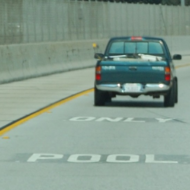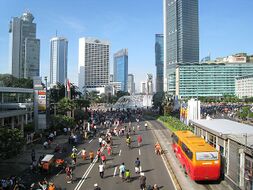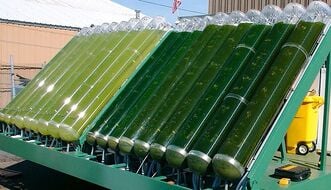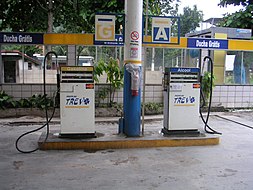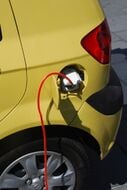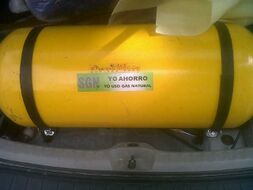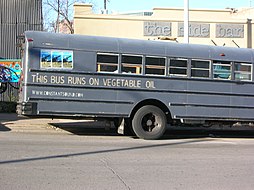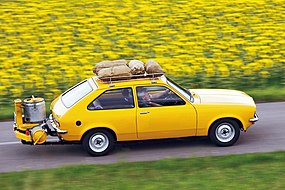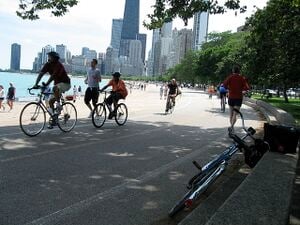
Sustainable transport refers to ways of transportation that are sustainable in terms of their social and environmental impacts. Components for evaluating sustainability include the particular vehicles used for road, water or air transport; the source of energy; and the infrastructure used to accommodate the transport (roads, railways, airways, waterways, canals and terminals). Transport operations and logistics as well as transit-oriented development are also involved in evaluation. Transportation sustainability is largely being measured by transportation system effectiveness and efficiency as well as the environmental and climate impacts of the system. Transport systems have significant impacts on the environment, accounting for between 20% and 25% of world energy consumption and carbon dioxide emissions. The majority of the emissions, almost 97%, came from direct burning of fossil fuels. In 2019, about 95% of the fuel came from fossil sources. The main source of greenhouse gas emissions in the European Union is transportation. In 2019 it contributes to about 31% of global emissions and 24% of emissions in the EU. In addition, up to the COVID-19 pandemic, emissions have only increased in this one sector. Greenhouse gas emissions from transport are increasing at a faster rate than any other energy using sector. Road transport is also a major contributor to local air pollution and smog.
Types[edit | edit source]
Alternative fuels[edit | edit source]
Here you will find different biofuels and other sustainable fuels that can be used as an alternative to conventional fuels.
"Appropriate technology" thinking in car design[edit | edit source]
Appropriate technology is not a term that is usually applied to cars, but many of the principles of appropriate technology are relevant.
The Citroën 2CVW is a rare example of a car that was designed (in the 1930's) for the poorer segment of society, to be extremely efficient and low-cost. And yet it was also considered a very comfortable car, in its own way, with a flexibility of use that many more expensive cars lacked. Its lack of modern safety features make it an unsuitable car for most settings today - however in affordability and efficiency remains unsurpassed. Its remarkable fuel-efficiency is still unsurpassed by modern micro-cars, and perhaps even by the latest petrol-electric hybrid vehicles.W
The Volkswagen BeetleW also had many similar characteristics as the 2CV, though not as extreme, eccentric or efficient.
The Tata NanoW is marketed in India as a cheap small family car that most workers would afford. But concerns have been going about the quality, safety and reliability of that product.[1][2][3]
Vehicles for the developing world[edit | edit source]
BUV,[1] from the Institute of Affordable Transportation, produces extremely basic three-wheeled open vehicles for passengers and goods, has the motto "Basic Vehicles - Changed Lives".
Other vehicles with an emphasis on basic design and low cost include the Indian companies Bajaj AutoW which makes tuk-tuks (motorized rickshaws) and Tata which makes the Tata Nano, a tiny low cost vehicle for city use.
Such basic design requires compromises on safety features. This may be offset by a very low top speed, or a target use where moderate to high speed crashes are rare (very remote areas, or in very heavy traffic in large cities).
Modern fuel-efficient cars[edit | edit source]
Some modern diesel cars can get better mileage than petrol hybrid electric vehicles. The Opel Eco Speedster (a concept car) gets up to 113 mpg (2.5 L/100km[4]). See The Opel Eco Speedster Says: Diesels Can Rip and Sip at the Same Time on treehugger.com; or Ultimatecarpage.com page (with a few technical comments). Solar-charged vehicles have a good mileage and do not use combustion.
Retro-fitted technology[edit | edit source]
Devices to save the energy from braking have been developed to fit to trucks. Due to the expense, they are only cost-effective for large trucks, where heavy fuel use and long distances covered make it worthwhile.[verification needed]
Pedicabs[edit | edit source]
Pedicabs are among the simplest, lowest cost forms of transport. The traditional pedicab is pedal-powered, but motorized pedicabs (perhaps consisting motorcycles with a passenger section attached) are also in use in various cities in Asia.
Vehicle production[edit | edit source]
A carbon-zero Volvo plant:
- The Volvo Trucks' manufacturing plant in Ghent, Belgium has become the first vehicle manufacturing facility in the world to operate without releasing any carbon dioxide. The Volvo Group intends to make all of their vehicle manufacturing plants carbon-zero as part of the European Union-wide goal of reducing carbon dioxide emissions by twenty percent by 2020.[5]
Appropriate use of vehicle types[edit | edit source]
To determine the most fuel-efficient vehicle type in a specific situation, see See Appropriate methods of transport
To determine a vehicle type based on various factors (including cost, speed,...) use the table below.
Note: While this table may be a useful starting guide, please also bear in mind several caveats of the difficulty of quantifying modes of transport for a direct comparison. 2 particular issues are highlighted below
- Regarding 'cost', there is the issue of direct 'cost' to the user in terms of e.g. buying a vehicle and paying for maintenance, versus the indirect costs paid by the larger society, and ultimately subsidised by e.g. taxation. Whilst the "infrastructure investment" heading tries to capture some of this issue, in the case of the automobile particularly this is challenging as "infrastructure" involves not just roads but arguably a global network of oil rigs, steel mines and rubber plantations, refineries, shipping, a network of petrol stations, etc. Whilst bicycles and other modes do draw on the same global infrastructure, the automobile drives it to a far greater degree.
- Secondly, the "cost" of any mode of transport involves negative externalities. Whilst some of these are included in the table below in the "Environmental, aesthetic and social impacts" column, again especially for car based transport these are now understood to be very broad - I.E. "social" impacts needs to include the very high cost of millions of car-related road deaths and trauma - as well as in affluent societies, we are now identifying the link between a car-based lifestyle and increasing rates of obesity and related illnesses.
| Mode | Single journey range (km) / optimal (feasible) | Speed of journey within optimal range | Cost | Mass transport capacity | Reach/ Coverage | Safety | On-demand | Infrastructure investment | Comfort | Customer Acceptance | Fuel Efficiency | Environmental, aesthetic and social impacts | Land Use |
| Walking | 0-2 (0-6) | ||||||||||||
| Bicycle | 0-6 (0-30) | ||||||||||||
| Motorized bicycle | 0-6 (0-30) | ||||||||||||
| Car | 3-300 (0-1500) | ||||||||||||
| Motorcycle | 3-100 (0-1500) | ||||||||||||
| Bus (urban) | 0.2-20 (0.2-50) | ||||||||||||
| Coach (long distance) | 1-300 (1-3000) | ||||||||||||
| Urban Rail/ Metro | 1-20 (0.3-50) | ||||||||||||
| Conventional Rail | 10-300 (0.3-5000) | ||||||||||||
| High Speed Rail/ Maglev | 100-800 (10-10,000) | ||||||||||||
| Boat | 1-200 (0.2-20,000) | ||||||||||||
| Aeroplane | 600-20,000 (100-20,000) | ||||||||||||
| Helicopter | 10-500 (0-3000) | ||||||||||||
| Airship | 300-2000 (50-20,000) | ? | |||||||||||
| Cable Car | 0.3-10 (0.3-50) | ||||||||||||
| PRT | 1-100 (0.3-500) | ? | |||||||||||
| Elevator/Lift | 0.1-0.5 (0.02-0.5) | ||||||||||||
| Escalator | 0.1-0.5 (0.02-1) |
Tweaking old vehicles[edit | edit source]
Old vehicles can be made completely ecologic by means of changes to the propulsion technology. These changes include changing IC-engines to run on a emissionless fuel, or swapping out the engine altogether for ie a electric motor,...
See also[edit | edit source]
- SkyCab and Shweeb: railed vehicles suspended above the ground that can be directed to a specific destination (unlike most public transport vehicles as city buses,...) See also http://www.sakaramenta.com/
- Electric vehicle
- Hybrid vehicles
- Green tuning of vehicles
- Public transport
- Sustainable transport activism
- Transport modeling reform
External links[edit | edit source]
There are many websites and groups around the world with a significant focus on sustainable transportation, in different contexts and countries.
Some of the significant research and communication centers focused primarily on this topic and working towards broad, systematic change are:
- The EMBARQ project, http://www.embarq.org/:- "EMBARQ's mission is to catalyze and help implement sustainable transport solutions to improve quality of life in cities."
- The World Streets website and community, http://worldstreets.wordpress.com/:- "World Streets consistently argues for and supports Equity-Based Transportation Policies in the interest of efficiency, economy and environment. (Click to get started.)."
- The Streets Blog website, http://www.streetsblog.org/:- "Streetsblog is a daily news source connecting people to information about sustainable transportation and livable communities."
Other useful information sources:
- Better transport section of the freely available e-Book, 'Sustainable Energy: Without the Hot Air, by Professor David MacKay. Includes details of energy use requirements of different transport modes.
- ↑ http://www.ecch.com/casesearch/product_details.cfm?id=84042
- ↑ http://web.archive.org/web/20100401050056/http://www.straitstimes.com:80/BreakingNews/Money/Story/STIStory_506890.html
- ↑ http://www.ihipo.com/index.php?q=group/China/Car+pollution+questioned+as+Tata+Nano+is+released
- ↑ This conversion assumes the figure is in imperial gallons. If the 113 mpg is US gallons, that equals 136 mpg in imperial gallons; or 2.1 L/100km)
- ↑ from The Web of Hope Newsletter, October 2007

